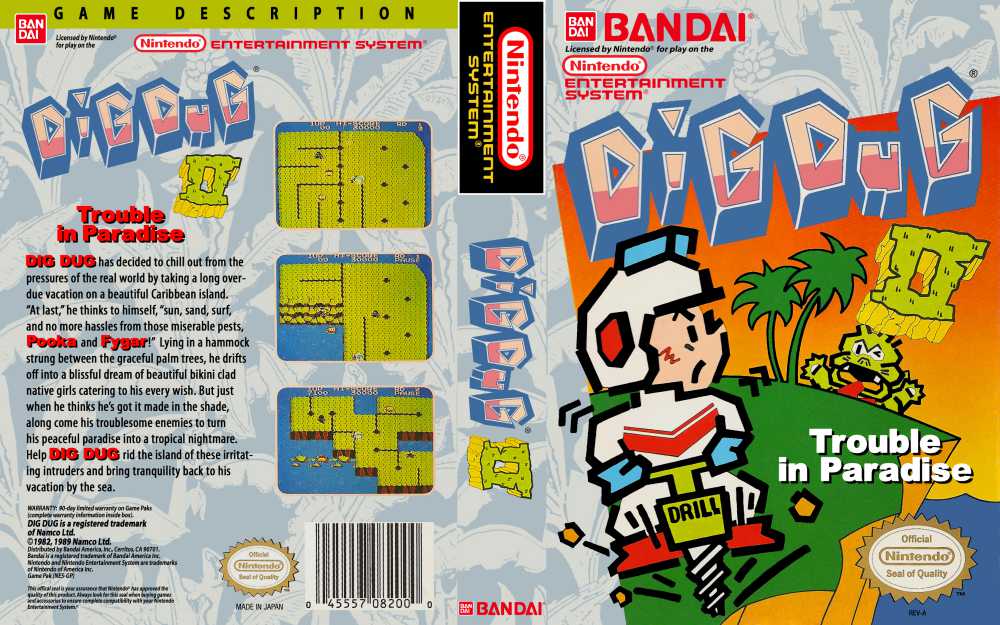The game I chose to play was Dig Dug II, originally released in 1985 on the NES console. I played Dig Dug II on my Nintendo Switch Lite, which offered a slightly different play experience than given on the NES. In Dig Dug II, gameplay takes place on an island where players have a top-down view of their character as he navigates the island. On the island are two types of enemies, dragons and Pookas, round enemies with goggles. Players have two options for defeating these enemies: the first is an air pump which players can use to pump air into enemies until they burst, and the second option is a jackhammer which players use to carve fault lines into the island terrain until large chunks of the island fall into the water, taking enemies with them. Once all the enemies are defeated players go on to the next round where the island terrain has shifted, and the number of enemies has changed as well.

The controls of the game on the Switch Lite were relatively similar to those on the NES. With both consoles, players use the control pad to evade enemies and use the B and A buttons to pump air and dig fault lines, respectively. However, with my Switch I was able to obtain two more abilities. One of those abilities was using the L stick to navigate my character rather than the control pad. After playing a few rounds of the game using the control pad to navigate the island, I switched to using the L Stick and found changing directions to be slightly easier. I say slightly because the response time in Dig Dug II is not instantaneous. Regardless of if I used the control pad or the L stick, my character always took a second to change directions, leading me to become frustrated as I died very often in the first few rounds. After a bit of playtime, however, I began to time my direction changes, considering the extra time it would take to wait for my character to actually change directions. The (small) wait time after entering controls seemed to be reserved for movement, as my character’s reaction after pressing buttons to use my air pump or jackhammer were almost immediate. What was interesting about using these two “weapons” was the fact that I couldn’t use them and move at the same time. If I was moving and activated my air pump, for example, my character would immediately stop walking to use it, leaving me vulnerable to being attacked by enemies other than the one I was attacking. The same response occurred when I tried to use my jackhammer while moving. I imagine these restrictions of movement and the slightly delayed movement response would be present if I’d played on the NES. While the delayed movement response frustrated me at first, I grew to appreciate how these game mechanics transferred over from the original console to my switch, allowing me to get closer to the authentic Dig Dug II experience.
The second gameplay ability I obtained actually brought me further from the authentic Dig Dug II experience. This was the ability to go back in time. Whenever an enemy killed me, I could hold the ZL and ZR triggers simultaneously and rewind to the moment just before I died, maintaining my three lives and prolonging the “Game Over” screen for as long as I wanted. I imagine this ability was not present in the original NES release, as it would defeat the purpose of giving a player only three lives and remove any stakes the game created. When I first discovered this ability, I used it every time I died, even if I knew I had more lives left to lose. It became slightly addictive to use and, as I said, diminished the stakes of the game. I no longer worried about enemies catching me as I maneuvered around the island because I knew I had an instant revival at my disposal. In bypassing the constraints present in the NES, the rewind button removed the stakes of the game and made it slightly less fun. I began to bar myself from using the rewind button and those stakes immediately came back. Although it was frustrating to be on round 20 and have to start over because I lost my last life, it made gameplay up to that moment much more fun. The moves I made mattered and had real consequences.
With Dig Dug II, the mission is simple, continue defeating enemies until you eventually die. However, the addition of the Switch’s rewind control alters that mission. There’s no death state, so the game never truly ends until the player decides to end it. Playing Dig Dug II on the Switch provided a slightly altered experience that called me to notice how varied and added game controls can change how players interact with and respond to a game. If I can never truly lose, does that change the meaning of the game? Is it even a game if there’s no longer a lose state? Does playing a game created for NES in 1985 a Switch in 2022 already change the game, before even using the rewind feature?

